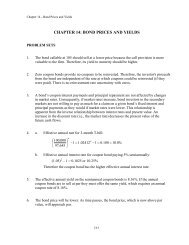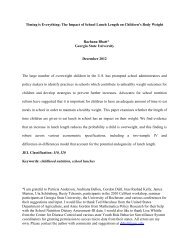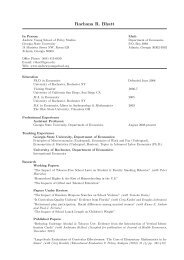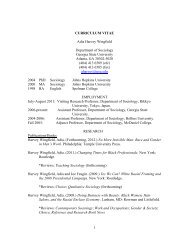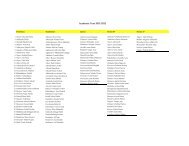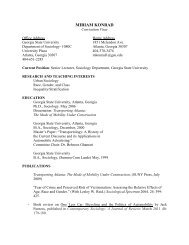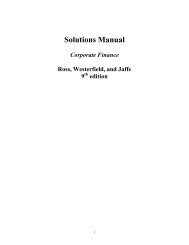Chapter 3 Analysis of Financial Statements
Chapter 3 Analysis of Financial Statements
Chapter 3 Analysis of Financial Statements
Create successful ePaper yourself
Turn your PDF publications into a flip-book with our unique Google optimized e-Paper software.
<strong>Chapter</strong> 3<br />
<strong>Analysis</strong> <strong>of</strong> <strong>Financial</strong> <strong>Statements</strong><br />
ANSWERS TO END-OF-CHAPTER QUESTIONS<br />
3-1 a. A liquidity ratio is a ratio that shows the relationship <strong>of</strong> a firm’s<br />
cash and other current assets to its current liabilities. The current<br />
ratio is found by dividing current assets by current liabilities. It<br />
indicates the extent to which current liabilities are covered by those<br />
assets expected to be converted to cash in the near future. The quick,<br />
or acid test, ratio is found by taking current assets less inventories<br />
and then dividing by current liabilities.<br />
b. Asset management ratios are a set <strong>of</strong> ratios which measure how<br />
effectively a firm is managing its assets. The inventory turnover<br />
ratio is sales divided by inventories. Days sales outstanding is used<br />
to appraise accounts receivable and indicates the length <strong>of</strong> time the<br />
firm must wait after making a sale before receiving cash. It is found<br />
by dividing receivables by average sales per day. The fixed assets<br />
turnover ratio measures how effectively the firm uses its plant and<br />
equipment. It is the ratio <strong>of</strong> sales to net fixed assets. Total assets<br />
turnover ratio measures the turnover <strong>of</strong> all the firm’s assets; it is<br />
calculated by dividing sales by total assets.<br />
c. <strong>Financial</strong> leverage ratios measure the use <strong>of</strong> debt financing. The debt<br />
ratio is the ratio <strong>of</strong> total debt to total assets, it measures the<br />
percentage <strong>of</strong> funds provided by creditors. The times-interest-earned<br />
ratio is determined by dividing earnings before interest and taxes by<br />
the interest charges. This ratio measures the extent to which<br />
operating income can decline before the firm is unable to meet its<br />
annual interest costs. The EBITDA coverage ratio is similar to the<br />
times-interest-earned ratio, but it recognizes that many firms lease<br />
assets and also must make sinking fund payments. It is found by adding<br />
EBITDA and lease payments then dividing this total by interest charges,<br />
lease payments, and sinking fund payments over one minus the tax rate.<br />
d. Pr<strong>of</strong>itability ratios are a group <strong>of</strong> ratios which show the combined<br />
effects <strong>of</strong> liquidity, asset management, and debt on operations. The<br />
pr<strong>of</strong>it margin on sales, calculated by dividing net income by sales,<br />
gives the pr<strong>of</strong>it per dollar <strong>of</strong> sales. Basic earning power is<br />
calculated by dividing EBIT by total assets. This ratio shows the raw<br />
earning power <strong>of</strong> the firm’s assets, before the influence <strong>of</strong> taxes and<br />
leverage. Return on total assets is the ratio <strong>of</strong> net income to total<br />
assets. Return on common equity is found by dividing net income into<br />
common equity.<br />
Harcourt, Inc. items and derived items copyright © 2002 by Harcourt, Inc. Answers and Solutions: 3 - 1
e. Market value ratios relate the firm’s stock price to its earnings and<br />
book value per share. The price/earnings ratio is calculated by<br />
dividing price per share by earnings per share--this shows how much<br />
investors are willing to pay per dollar <strong>of</strong> reported pr<strong>of</strong>its. The<br />
price/cash flow is calculated by dividing price per share by cash flow<br />
per share. This shows how much investors are willing to pay per dollar<br />
<strong>of</strong> cash flow. Market-to-book ratio is simply the market price per<br />
share divided by the book value per share. Book value per share is<br />
common equity divided by the number <strong>of</strong> shares outstanding.<br />
f. Trend analysis is an analysis <strong>of</strong> a firm’s financial ratios over time.<br />
It is used to estimate the likelihood <strong>of</strong> improvement or deterioration<br />
in its financial situation. Comparative ratio analysis is when a firm<br />
compares its ratios to other leading companies in the same industry.<br />
This technique is also known as benchmarking.<br />
g. The Du Pont chart is a chart designed to show the relationships among<br />
return on investment, asset turnover, the pr<strong>of</strong>it margin, and leverage.<br />
The Du Pont equation is a formula which shows that the rate <strong>of</strong> return<br />
on assets can be found as the product <strong>of</strong> the pr<strong>of</strong>it margin times the<br />
total assets turnover.<br />
h. Window dressing is a technique employed by firms to make their<br />
financial statements look better than they really are. Seasonal<br />
factors can distort ratio analysis. At certain times <strong>of</strong> the year a<br />
firm may have excessive inventories in preparation <strong>of</strong> a “season” <strong>of</strong><br />
high demand. Therefore an inventory turnover ratio taken at this time<br />
as opposed to after the season will be radically distorted.<br />
3-2 The emphasis <strong>of</strong> the various types <strong>of</strong> analysts is by no means uniform nor<br />
should it be. Management is interested in all types <strong>of</strong> ratios for two<br />
reasons. First, the ratios point out weaknesses that should be<br />
strengthened; second, management recognizes that the other parties are<br />
interested in all the ratios and that financial appearances must be kept<br />
up if the firm is to be regarded highly by creditors and equity investors.<br />
Equity investors are interested primarily in pr<strong>of</strong>itability, but they<br />
examine the other ratios to get information on the riskiness <strong>of</strong> equity<br />
commitments. Long-term creditors are more interested in the debt ratio,<br />
TIE, and fixed-charge coverage ratios, as well as the pr<strong>of</strong>itability<br />
ratios. Short-term creditors emphasize liquidity and look most carefully<br />
at the liquidity ratios.<br />
3-3 The inventory turnover ratio is important to a grocery store because <strong>of</strong><br />
the much larger inventory required and because some <strong>of</strong> that inventory is<br />
perishable. An insurance company would have no inventory to speak <strong>of</strong><br />
since its line <strong>of</strong> business is selling insurance policies or other similar<br />
financial products--contracts written on paper and entered into between<br />
the company and the insured. This question demonstrates the fact that the<br />
student should not take a routine approach to financial analysis but<br />
rather should examine the particular business he or she is dealing with.<br />
Answers and Solutions: 3 - 2 Harcourt, Inc. items and derived items copyright © 2002 by Harcourt, Inc.
3-4 Given that sales have not changed, a decrease in the total assets turnover<br />
means that the company’s assets have increased. Also, the fact that the<br />
fixed assets turnover ratio remained constant implies that the company<br />
increased its current assets. Since the company’s current ratio<br />
increased, and yet, its quick ratio is unchanged means that the company<br />
has increased its inventories.<br />
3-5 Differences in the amounts <strong>of</strong> assets necessary to generate a dollar <strong>of</strong><br />
sales cause asset turnover ratios to vary among industries. For example,<br />
a steel company needs a greater number <strong>of</strong> dollars in assets to produce a<br />
dollar in sales than does a grocery store chain. Also, pr<strong>of</strong>it margins and<br />
turnover ratios may vary due to differences in the amount <strong>of</strong> expenses<br />
incurred to produce sales. For example, one would expect a grocery store<br />
chain to spend more per dollar <strong>of</strong> sales than does a steel company. Often,<br />
a large turnover will be associated with a low pr<strong>of</strong>it margin, and vice<br />
versa.<br />
3-6 Inflation will cause earnings to increase, even if there is no increase in<br />
sales volume. Yet, the book value <strong>of</strong> the assets that produced the sales<br />
and the annual depreciation expense remain at historic values and do not<br />
reflect the actual cost <strong>of</strong> replacing those assets. Thus, ratios that<br />
compare current flows with historic values become distorted over time.<br />
For example, ROA will increase even though those assets are generating the<br />
same sales volume.<br />
When comparing different companies, the age <strong>of</strong> the assets will greatly<br />
affect the ratios. Companies whose assets were purchased earlier will<br />
reflect lower asset values than those that purchased the assets later at<br />
inflated prices. Two firms with similar physical assets and sales could<br />
have significantly different ROAs. Under inflation, ratios will also<br />
reflect differences in the way firms treat inventories. As can be seen,<br />
inflation affects both income statement and balance sheet items.<br />
3-7 ROE, using the Du Pont equation, is the return on assets multiplied by the<br />
equity multiplier. The equity multiplier, defined as total assets divided<br />
by owners’ equity, is a measure <strong>of</strong> debt utilization; the more debt a firm<br />
uses, the lower its equity, and the higher the equity multiplier. Thus,<br />
using more debt will increase the equity multiplier, resulting in a higher<br />
ROE.<br />
3-8 a. Cash, receivables, and inventories, as well as current liabilities,<br />
vary over the year for firms with seasonal sales patterns. Therefore,<br />
those ratios that examine balance sheet figures will vary unless<br />
averages (monthly ones are best) are used.<br />
b. Common equity is determined at a point in time, say December 31, 2001.<br />
Pr<strong>of</strong>its are earned over time, say during 2001. If a firm is growing<br />
rapidly, year-end equity will be much larger than beginning-<strong>of</strong>-year<br />
equity, so the calculated rate <strong>of</strong> return on equity will be different<br />
depending on whether end-<strong>of</strong>-year, beginning-<strong>of</strong>-year, or average common<br />
equity is used as the denominator. Average common equity is<br />
conceptually the best figure to use. In public utility rate cases,<br />
people are reported to have deliberately used end-<strong>of</strong>-year or beginning-<br />
Harcourt, Inc. items and derived items copyright © 2002 by Harcourt, Inc. Answers and Solutions: 3 - 3
<strong>of</strong>-year equity to make returns on equity appear excessive or<br />
inadequate. Similar problems can arise when a firm is being evaluated.<br />
3-9 Firms within the same industry may employ different accounting techniques<br />
which make it difficult to compare financial ratios. More fundamentally,<br />
comparisons may be misleading if firms in the same industry differ in<br />
their other investments. For example, comparing Pepsico and Coca-Cola may<br />
be misleading because apart from their s<strong>of</strong>t drink business, Pepsi also<br />
owns other businesses such as Frito-Lay, Pizza Hut, Taco Bell, and KFC.<br />
3-10 Total Effect<br />
Current Current on Net<br />
Assets Ratio Income<br />
a. Cash is acquired through issuance <strong>of</strong><br />
additional common stock. + + 0<br />
b. Merchandise is sold for cash. + + +<br />
c. Federal income tax due for the previous<br />
year is paid. - + 0<br />
d. A fixed asset is sold for less than<br />
book value. + + -<br />
e. A fixed asset is sold for more than<br />
book value. + + +<br />
f. Merchandise is sold on credit. + + +<br />
g. Payment is made to trade creditors for<br />
previous purchases. - + 0<br />
h. A cash dividend is declared and paid. - - 0<br />
i. Cash is obtained through short-term bank<br />
loans. + - 0<br />
j. Short-term notes receivable are sold at<br />
a discount. - - -<br />
k. Marketable securities are sold below cost. - - -<br />
l. Advances are made to employees. 0 0 0<br />
m. Current operating expenses are paid. - - -<br />
Answers and Solutions: 3 - 4 Harcourt, Inc. items and derived items copyright © 2002 by Harcourt, Inc.
Total Effect<br />
Current Current on Net<br />
Assets Ratio Income<br />
n. Short-term promissory notes are issued to<br />
trade creditors in exchange for past due<br />
accounts payable. 0 0 0<br />
o. Ten-year notes are issued to pay <strong>of</strong>f<br />
accounts payable. 0 + 0<br />
p. A fully depreciated asset is retired. 0 0 0<br />
q. Accounts receivable are collected. 0 0 0<br />
r. Equipment is purchased with short-term<br />
notes. 0 - 0<br />
s. Merchandise is purchased on credit. + - 0<br />
t. The estimated taxes payable are increased. 0 - -<br />
Harcourt, Inc. items and derived items copyright © 2002 by Harcourt, Inc. Answers and Solutions: 3 - 5
CA<br />
3-1 CA = $3,000,000; = 1.5;<br />
CL<br />
CL = ?; I = ?<br />
CA<br />
= 1.5<br />
CL<br />
$3,000,000<br />
= 1.5<br />
CL<br />
1.5 CL = $3,000,000<br />
CL<br />
=<br />
$2,000,000.<br />
CA - I<br />
= 1.0<br />
CL<br />
$3,000,000 - I<br />
= 1.0<br />
$2,000,000<br />
$3,000,000 - I = $2,000,000<br />
I<br />
=<br />
$1,000,000.<br />
CA - I<br />
3-2 DSO = 40 days; ADS = $20,000; AR = ?<br />
40<br />
DSO<br />
=<br />
=<br />
AR<br />
S<br />
360<br />
AR<br />
$20,000<br />
AR = $800,000.<br />
3-3 A/E = 2.4; D/A = ?<br />
SOLUTIONS TO END-OF-CHAPTER PROBLEMS<br />
⎛<br />
D<br />
⎜<br />
= ⎜1<br />
-<br />
A ⎜<br />
⎝<br />
⎞<br />
1<br />
⎟<br />
⎟<br />
A ⎟<br />
E ⎠<br />
D ⎛ 1 ⎞<br />
= ⎜1<br />
- ⎟<br />
A ⎝ 2.4⎠<br />
D<br />
= 0.5833 = 58.33%.<br />
A<br />
CL<br />
= 1.0;<br />
Answers and Solutions: 3 - 6 Harcourt, Inc. items and derived items copyright © 2002 by Harcourt, Inc.
3-4 ROA = 10%; PM = 2%; ROE = 15%; S/TA = ?; A/E = ?<br />
ROA = NI/A; PM = NI/S; ROE = NI/E<br />
ROA = PM × S/TA<br />
NI/A = NI/S × S/TA<br />
10% = 2% × S/TA<br />
S/TA = 5.<br />
ROE = PM × S/TA × TA/E<br />
NI/E = NI/S × S/TA × TA/E<br />
15% = 2% × 5 × TA/E<br />
15% = 10% × TA/E<br />
TA/E = 1.5.<br />
3-5 We are given ROA = 3% and Sales/Total assets = 1.5×.<br />
From Du Pont equation: ROA = Pr<strong>of</strong>it margin × Total assets turnover<br />
3% = Pr<strong>of</strong>it margin (1.5)<br />
Pr<strong>of</strong>it margin = 3%/1.5 = 2%.<br />
We can also calculate the company’s debt ratio in a similar manner, given<br />
the facts <strong>of</strong> the problem. We are given ROA(NI/A) and ROE(NI/E); if we use<br />
the reciprocal <strong>of</strong> ROE we have the following equation:<br />
Alternatively,<br />
Take reciprocal:<br />
therefore,<br />
E NI E D E<br />
= _ and = 1 - , so<br />
A A NI A A<br />
E 1<br />
= 3% _<br />
A 0.05<br />
E<br />
= 60% .<br />
A<br />
D<br />
= 1 - 0.60 = 0.40 = 40% .<br />
A<br />
ROE = ROA × EM<br />
5% = 3% × EM<br />
EM = 5%/3% = 5/3 = TA/E.<br />
E/TA = 3/5 = 60%;<br />
D/A = 1 - 0.60 = 0.40 = 40%.<br />
Thus, the firm’s pr<strong>of</strong>it margin = 2% and its debt ratio = 40%.<br />
Harcourt, Inc. items and derived items copyright © 2002 by Harcourt, Inc. Answers and Solutions: 3 - 7
$1,312,500<br />
3-6 Present current ratio = = 2.5.<br />
$525,000<br />
3-7 1.<br />
Minimum current ratio =<br />
$1,312,500 + Δ<br />
$525,000<br />
$1,312,500 + ΔNP = $1,050,000 + 2ΔNP<br />
ΔNP = $262,500.<br />
Answers and Solutions: 3 - 8 Harcourt, Inc. items and derived items copyright © 2002 by Harcourt, Inc.<br />
+<br />
Δ<br />
NP<br />
NP<br />
= 2.0.<br />
Short-term debt can increase by a maximum <strong>of</strong> $262,500 without violating a<br />
2 to 1 current ratio, assuming that the entire increase in notes payable<br />
is used to increase current assets. Since we assumed that the additional<br />
funds would be used to increase inventory, the inventory account will<br />
increase to $637,500, and current assets will total $1,575,000.<br />
Quick ratio = ($1,575,000 - $637,500)/$787,500 = $937,500/$787,500 = 1.19×.<br />
2.<br />
Current assets<br />
Current liabilities<br />
= 3.0×<br />
Current liabilities = $270,000.<br />
Current<br />
assets - Inventories<br />
Current liabilities<br />
Inventories = $432,000.<br />
$810,000<br />
Current liabilities<br />
= 1.4×<br />
$810,000 -<br />
$270,000<br />
Current Marketable Accounts<br />
3.<br />
assets<br />
= Cash +<br />
Securities<br />
+<br />
receivable<br />
+ Inventories<br />
= 3.0×<br />
Inventories<br />
$810,000 = $120,000 + Accounts receivable + $432,000<br />
Accounts receivable = $258,000.<br />
Sales<br />
4.<br />
Inventory<br />
= 6.0×<br />
Sales = $2,592,000.<br />
5. DSO =<br />
Accounts receivable<br />
Sales/ 360<br />
Sales<br />
= 6.0×<br />
$432,000<br />
=<br />
$258,000<br />
$2,592,000/<br />
360<br />
= 36 days.<br />
3-8 TIE = EBIT/INT, so find EBIT and INT.<br />
Interest = $500,000 × 0.1 = $50,000.<br />
Net income = $2,000,000 × 0.05 = $100,000.<br />
Pre-tax income = $100,000/(1 - T) = $100,000/0.7 = $142,857.<br />
EBIT = $142,857 + $50,000 = $192,857.<br />
TIE = $192,857/$50,000 = 3.86×.<br />
= 1.4×
3-9 ROE = Pr<strong>of</strong>it margin × TA turnover × Equity multiplier<br />
= NI/Sales × Sales/TA × TA/Equity.<br />
Now we need to determine the inputs for the equation from the data that<br />
were given. On the left we set up an income statement, and we put numbers<br />
in it on the right:<br />
Sales (given) $10,000,000<br />
Cost na____<br />
EBIT (given) $ 1,000,000<br />
INT (given) 300,000<br />
EBT $ 700,000<br />
Taxes (34%) 238,000<br />
NI $ 462,000<br />
Now we can use some ratios to get some more data:<br />
Total assets turnover = 2 = S/TA; TA = S/2 = $10,000,000/2 = $5,000,000.<br />
D/A = 60%; so E/A = 40%; and, therefore,<br />
Equity multiplier = TA/E = 1/(E/A) = 1/0.4 = 2.5.<br />
Now we can complete the Du Pont equation to determine ROE:<br />
ROE = $462,000/$10,000,000 × $10,000,000/$5,000,000 × 2.5 = 0.231 = 23.1%.<br />
3-10 Known data:<br />
TA = $1,000,000<br />
BEP = 0.2 = EBIT/Total assets, so EBIT = 0.2($1,000,000) = $200,000.<br />
k d = 8%<br />
T = 40%<br />
D/A = 0.5 = 50%, so Equity = $500,000.<br />
NI<br />
ROE =<br />
Equity<br />
D/A = 0% D/A = 50%<br />
EBIT $200,000 $200,000<br />
Interest 0 40,000*<br />
EBT $200,000 $160,000<br />
Tax (40%) 80,000 64,000<br />
NI $120,000 $ 96,000<br />
$120,000 $96,000<br />
= = 12%; = 19.2%.<br />
$1,000,000 $500,000<br />
Difference in ROE = 19.2% - 12.0% = 7.2%.<br />
*If D/A = 50%, then half <strong>of</strong> assets are financed by debt, so Debt =<br />
$500,000. At an 8% interest rate, INT = $40,000.<br />
3-11 Statement a is correct. Refer to the solution setup for Problem 3-10 and<br />
Harcourt, Inc. items and derived items copyright © 2002 by Harcourt, Inc. Answers and Solutions: 3 - 9
think about it this way: (1) Adding assets will not affect common equity<br />
if the assets are financed with debt. (2) Adding assets will cause<br />
expected EBIT to increase by the amount EBIT = BEP(added assets). (3)<br />
Interest expense will increase by the amount k d(added assets). (4) Pre-tax<br />
income will rise by the amount (added assets)(BEP - k d). Assuming BEP ><br />
k d, if pre-tax income increases so will net income. (5) If expected net<br />
income increases but common equity is held constant, then the expected ROE<br />
will also increase. Note that if k d > BEP, then adding assets financed by<br />
debt would lower net income and thus the ROE. Therefore, Statement a is<br />
true--if assets financed by debt are added, and if the expected BEP on<br />
those assets exceeds the cost <strong>of</strong> debt, then the firm’s ROE will increase.<br />
<strong>Statements</strong> b and c are false, because the BEP ratio uses EBIT, which is<br />
calculated before the effects <strong>of</strong> taxes or interest charges are felt, and d<br />
is false unless k d > BEP. Of course, Statement e is also false.<br />
3-12 a. Currently, ROE is ROE 1 = $15,000/$200,000 = 7.5%.<br />
The current ratio will be set such that 2.5 = CA/CL. CL is $50,000,<br />
and it will not change, so we can solve to find the new level <strong>of</strong><br />
current assets: CA = 2.5(CL) = 2.5($50,000) = $125,000. This is the<br />
level <strong>of</strong> current assets that will produce a current ratio <strong>of</strong> 2.5×.<br />
At present, current assets amount to $210,000, so they can be<br />
reduced by $210,000 - $125,000 = $85,000. If the $85,000 generated is<br />
used to retire common equity, then the new common equity balance will<br />
be $200,000 - $85,000 = $115,000.<br />
Assuming that net income is unchanged, the new ROE will be ROE 2 =<br />
$15,000/$115,000 = 13.04%. Therefore, ROE will increase by 13.04% -<br />
7.50% = 5.54%.<br />
b. 1. Doubling the dollar amounts would not affect the answer; it would<br />
still be 5.54%.<br />
2. Common equity would increase by $25,000 from the Part a scenario,<br />
which would mean a new ROE <strong>of</strong> $15,000/$140,000 = 10.71%, which would<br />
mean a difference <strong>of</strong> 10.71% - 7.50% = 3.21%.<br />
3. An inventory turnover <strong>of</strong> 2 would mean inventories <strong>of</strong> $100,000, down<br />
$50,000 from the current level. That would mean an ROE <strong>of</strong><br />
$15,000/$150,000 = 10.00%, so the change in ROE would be 10.00% -<br />
7.5% = 2.5%.<br />
4. If the company had 10,000 shares outstanding, then its EPS would be<br />
$15,000/10,000 = $1.50. The stock has a book value <strong>of</strong><br />
$200,000/10,000 = $20, so the shares retired would be $85,000/$20 =<br />
4,250, leaving 10,000 - 4,250 = 5,750 shares. The new EPS would be<br />
$15,000/5,750 = $2.6087, so the increase in EPS would be $2.6087 -<br />
$1.50 = $1.1087, which is a 73.91% increase, the same as the<br />
increase in ROE.<br />
5. If the stock was selling for twice book value, or 2 x $20 = $40,<br />
then only half as many shares could be retired ($85,000/$40 =<br />
2,125), so the remaining shares would be 10,000 - 2,125 = 7,875, and<br />
Answers and Solutions: 3 - 10 Harcourt, Inc. items and derived items copyright © 2002 by Harcourt, Inc.
the new EPS would be $15,000/7,875 = $1.9048, for an increase <strong>of</strong><br />
$1.9048 - $1.5000 = $0.4048.<br />
c. We could have started with lower inventory and higher accounts<br />
receivable, then had you calculate the DSO, then move to a lower DSO<br />
which would require a reduction in receivables, and then determine the<br />
effects on ROE and EPS under different conditions. Similarly, we could<br />
have focused on fixed assets and the FA turnover ratio. In any <strong>of</strong><br />
these cases, we could have had you use the funds generated to retire<br />
debt, which would have lowered interest charges and consequently<br />
increased net income and EPS.<br />
If we had to increase assets, then we would have had to finance this<br />
increase by adding either debt or equity, which would have lowered ROE<br />
and EPS, other things held constant.<br />
Finally, note that we could have asked some conceptual questions<br />
about the problem, either as a part <strong>of</strong> the problem or without any<br />
reference to the problem. For example, “If funds are generated by<br />
reducing assets, and if those funds are used to retire common stock,<br />
will EPS and/or ROE be affected by whether or not the stock sells<br />
above, at, or below book value?”<br />
3-13 a. (Dollar amounts in thousands.)<br />
DSO =<br />
Current assets<br />
Current liabilities<br />
Accounts receivable<br />
Sales/ 360<br />
Inventory<br />
Fixed<br />
Total<br />
Sales<br />
Sales<br />
assets<br />
Sales<br />
assets<br />
Net income<br />
Net<br />
Total<br />
Sales<br />
income<br />
assets<br />
Industry<br />
Firm Average<br />
$655,000<br />
= = 1.98× 2.0×<br />
$330,000<br />
$336,000<br />
= = 75 days 35 days<br />
$4,465.28<br />
$1,607,500<br />
= = 6.66× 6.7×<br />
$241,500<br />
$1,607,500<br />
= = 5.50× 12.1×<br />
$292,500<br />
$1,607,500<br />
= = 1.70× 3.0×<br />
$947,500<br />
$27,300<br />
= = 1.7% 1.2%<br />
$1,607,500<br />
$27,300<br />
= = 2.9% 3.6%<br />
$947,500<br />
Harcourt, Inc. items and derived items copyright © 2002 by Harcourt, Inc. Answers and Solutions: 3 - 11
Net income<br />
Common<br />
b. For the firm,<br />
Total<br />
Total<br />
equity<br />
debt<br />
assets<br />
Industry<br />
Firm Average<br />
$27,300<br />
= = 7.6% 9.0%<br />
$361,000<br />
$586,500<br />
= = 61.9% 60.0%<br />
$947,500<br />
$947,500<br />
ROE = PM × T.A. turnover × EM = 1.7% × 1.7 × = 7.6%.<br />
$361,000<br />
For the industry, ROE = 1.2% × 3 × 2.5 = 9%.<br />
Note: To find the industry ratio <strong>of</strong> assets to common equity, recognize<br />
that 1 - (total debt/total assets) = common equity/total assets. So,<br />
common equity/total assets = 40%, and 1/0.40 = 2.5 = total<br />
assets/common equity.<br />
c. The firm’s days sales outstanding is more than twice as long as the<br />
industry average, indicating that the firm should tighten credit or<br />
enforce a more stringent collection policy. The total assets turnover<br />
ratio is well below the industry average so sales should be increased,<br />
assets decreased, or both. While the company’s pr<strong>of</strong>it margin is higher<br />
than the industry average, its other pr<strong>of</strong>itability ratios are low<br />
compared to the industry--net income should be higher given the amount<br />
<strong>of</strong> equity and assets. However, the company seems to be in an average<br />
liquidity position and financial leverage is similar to others in the<br />
industry.<br />
d. If 2001 represents a period <strong>of</strong> supernormal growth for the firm, ratios<br />
based on this year will be distorted and a comparison between them and<br />
industry averages will have little meaning. Potential investors who<br />
look only at 2001 ratios will be misled, and a return to normal<br />
conditions in 2002 could hurt the firm’s stock price.<br />
3-14 1. Debt = (0.50)(Total assets) = (0.50)($300,000) = $150,000.<br />
2. Accounts payable = Debt – Long-term debt = $150,000 - $60,000<br />
= $90,000<br />
3. Common stock =<br />
Total liabilities<br />
and equity<br />
- Debt - Retained earnings<br />
= $300,000 - $150,000 - $97,500 = $52,500.<br />
4. Sales = (1.5)(Total assets) = (1.5)($300,000) = $450,000.<br />
5. Inventory = Sales/5 = $450,000/5 = $90,000.<br />
Answers and Solutions: 3 - 12 Harcourt, Inc. items and derived items copyright © 2002 by Harcourt, Inc.
6. Accounts receivable = (Sales/360)(DSO) = ($450,000/360)(36)<br />
= $45,000.<br />
7. Cash + Accounts receivable = (0.80)(Accounts payable)<br />
Cash + $45,000 = (0.80)($90,000)<br />
Cash = $72,000 - $45,000 = $27,000.<br />
8. Fixed assets = Total assets - (Cash + Accts rec. + Inventories)<br />
= $300,000 - ($27,000 + $45,000 + $90,000) = $138,000.<br />
9. Cost <strong>of</strong> goods sold = (Sales)(1 - 0.25) = ($450,000)(0.75) = $337,500.<br />
3-15 a. (Dollar amounts in millions.) Industry<br />
Firm Average<br />
Current ratio =<br />
Debt to<br />
total assets<br />
Times interest<br />
earned<br />
=<br />
Current assets<br />
Current liabilities<br />
Total<br />
Debt<br />
assets<br />
EBIT<br />
=<br />
Interest<br />
EBITDA<br />
coverage<br />
= =<br />
Inventory Sales<br />
turnover<br />
=<br />
Inventory<br />
DSO =<br />
F.<br />
A.<br />
Turnover<br />
T.<br />
A.<br />
Turnover<br />
=<br />
=<br />
Pr<strong>of</strong>it margin =<br />
Return on<br />
total assets<br />
=<br />
Accounts receivable<br />
Sales/ 360<br />
Sales<br />
Net fixed<br />
Total<br />
Sales<br />
assets<br />
assets<br />
Net income<br />
Net<br />
Total<br />
Sales<br />
income<br />
assets<br />
$303<br />
= = 2.73× 2×<br />
$111<br />
$135<br />
= = 30% 30%<br />
$450<br />
$49.5<br />
= = 11× 7×<br />
$4.5<br />
$ 61.<br />
5<br />
$ 6.<br />
5<br />
= 9.46× 9×<br />
$795<br />
= = 5× 10×<br />
$159<br />
Harcourt, Inc. items and derived items copyright © 2002 by Harcourt, Inc. Answers and Solutions: 3 - 13<br />
=<br />
$66<br />
$795/<br />
360<br />
= 30 days 24 days<br />
$795<br />
= = 5.41× 6×<br />
$147<br />
$795<br />
= = 1.77× 3×<br />
$450<br />
$27<br />
= = 3.40% 3%<br />
$795<br />
$27<br />
= = 6.00% 9%<br />
$450<br />
Return on<br />
common equity<br />
= ROA × EM = 6% × 1.43 = 8.58% 12.9%
Alternatively,<br />
ROE =<br />
Net income<br />
Equity<br />
$27<br />
= = 8.6%.<br />
$315<br />
b. ROE = Pr<strong>of</strong>it margin × Total assets turnover × Equity multiplier<br />
=<br />
Net income<br />
Sales<br />
×<br />
Total<br />
Sales<br />
assets<br />
Answers and Solutions: 3 - 14 Harcourt, Inc. items and derived items copyright © 2002 by Harcourt, Inc.<br />
×<br />
Total assets<br />
Common<br />
equity<br />
$27 $795 $450<br />
= × × = 3.4% × 1.77 × 1.43 = 8.6%.<br />
$795 $450 $315<br />
Firm Industry Comment<br />
Pr<strong>of</strong>it margin 3.4% 3.0% Good<br />
Total assets turnover 1.77× 3.0× Poor<br />
Equity multiplier 1.43 1.43* Good<br />
D E<br />
* 1 - =<br />
TA TA<br />
1 – 0.30 = 0.7<br />
TA 1<br />
EM = = = 1.43.<br />
E 0.7<br />
Alternatively, EM = ROE/ROA = 12.9%/9% = 1.43.<br />
c. <strong>Analysis</strong> <strong>of</strong> the Du Pont equation and the set <strong>of</strong> ratios shows that the<br />
turnover ratio <strong>of</strong> sales to assets is quite low. Either sales should be<br />
increased at the present level <strong>of</strong> assets, or the current level <strong>of</strong><br />
assets should be decreased to be more in line with current sales.<br />
Thus, the problem appears to be in the balance sheet accounts.<br />
d. The comparison <strong>of</strong> inventory turnover ratios shows that other firms in<br />
the industry seem to be getting along with about half as much inventory<br />
per unit <strong>of</strong> sales as the firm. If the company’s inventory could be<br />
reduced, this would generate funds that could be used to retire debt,<br />
thus reducing interest charges and improving pr<strong>of</strong>its, and strengthening<br />
the debt position. There might also be some excess investment in fixed<br />
assets, perhaps indicative <strong>of</strong> excess capacity, as shown by a slightly<br />
lower-than-average fixed assets turnover ratio. However, this is not<br />
nearly as clear-cut as the overinvestment in inventory.<br />
e. If the firm had a sharp seasonal sales pattern, or if it grew rapidly<br />
during the year, many ratios might be distorted. Ratios involving<br />
cash, receivables, inventories, and current liabilities, as well as<br />
those based on sales, pr<strong>of</strong>its, and common equity, could be biased. It<br />
is possible to correct for such problems by using average rather than<br />
end-<strong>of</strong>-period figures.<br />
3-16 a. Here are the firm’s base case ratios and other data as compared to the
industry:<br />
Firm Industry Comment<br />
Quick 0.8× 1.0× Weak<br />
Current 2.3 2.7 Weak<br />
Inventory turnover 4.8 7.0 Poor<br />
Days sales outstanding 37 days 32 days Poor<br />
Fixed assets turnover 10.0× 13.0× Poor<br />
Total assets turnover 2.3 2.6 Poor<br />
Return on assets 5.9% 9.1% Bad<br />
Return on equity 13.1 18.2 Bad<br />
Debt ratio 54.8 50.0 High<br />
Pr<strong>of</strong>it margin on sales 2.5 3.5 Bad<br />
EPS $4.71 n.a. --<br />
Stock Price $23.57 n.a. --<br />
P/E ratio 5.0× 6.0× Poor<br />
P/CF ratio 2.0× 3.5× Poor<br />
M/B ratio 0.65 n.a. --<br />
The firm appears to be badly managed--all <strong>of</strong> its ratios are worse than<br />
the industry averages, and the result is low earnings, a low P/E, P/CF<br />
ratio, a low stock price, and a low M/B ratio. The company needs to do<br />
something to improve.<br />
b. A decrease in the inventory level would improve the inventory turnover,<br />
total assets turnover, and ROA, all <strong>of</strong> which are too low. It would<br />
have some impact on the current ratio, but it is difficult to say<br />
precisely how that ratio would be affected. If the lower inventory<br />
level allowed the company to reduce its current liabilities, then the<br />
current ratio would improve. The lower cost <strong>of</strong> goods sold would<br />
improve all <strong>of</strong> the pr<strong>of</strong>itability ratios and, if dividends were not<br />
increased, would lower the debt ratio through increased retained<br />
earnings. All <strong>of</strong> this should lead to a higher market/book ratio and a<br />
higher stock price.<br />
Harcourt, Inc. items and derived items copyright © 2002 by Harcourt, Inc. Answers and Solutions: 3 - 15


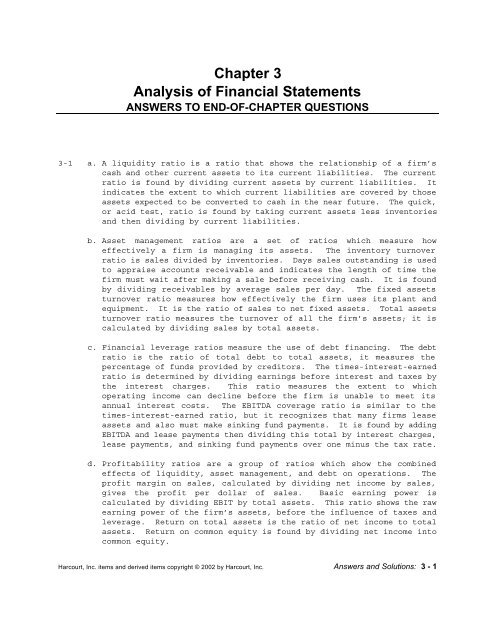
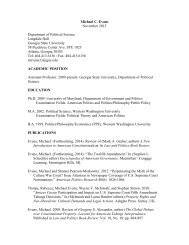
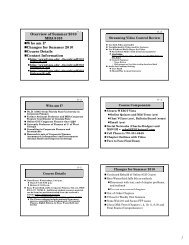
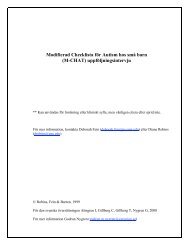
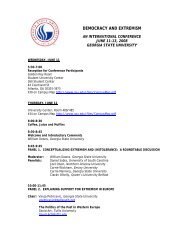
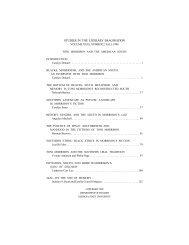
![HIST 4330--6920 Spring 2010 Kuhn[1] - Georgia State University](https://img.yumpu.com/15992617/1/190x245/hist-4330-6920-spring-2010-kuhn1-georgia-state-university.jpg?quality=85)

